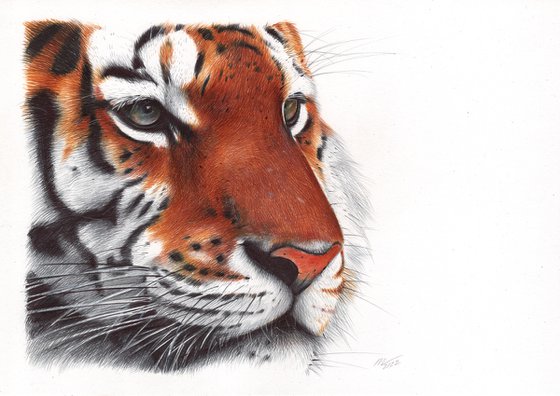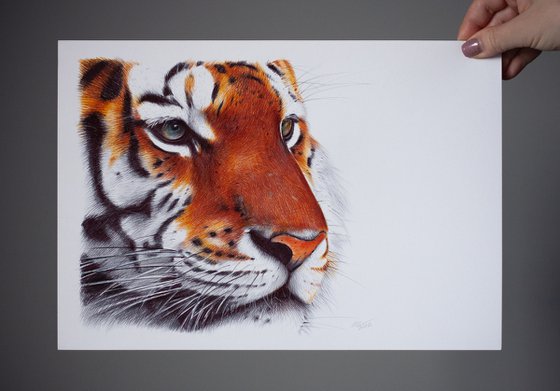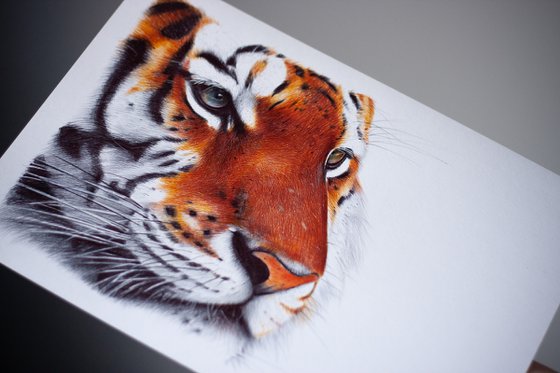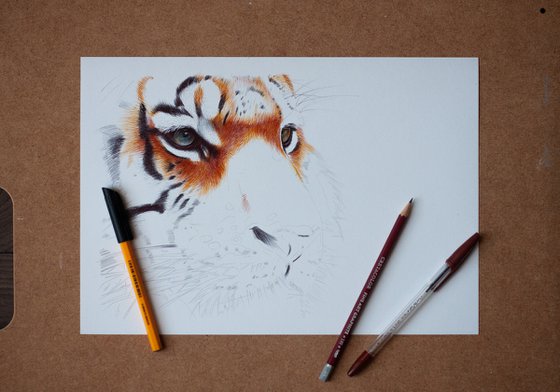- By medium
- By subject
- By budget
- Sales
- Gift cards
- Discover all art
- Artists
- Editors’ picks
- Ideas
Original artwork description:
Drawing of a tiger (lat. Panthera tigris).
It is the largest living cat species and a member of the genus Panthera. The tiger was first scientifically described in 1758 and once ranged widely from the Eastern Anatolia Region in the west to the Amur River basin in the east, and in the south from the foothills of the Himalayas to Bali in the Sunda Islands. Since the early 20th century, tiger populations have lost at least 93% of their historic range and have been extirpated from Western and Central Asia, the islands of Java and Bali, and in large areas of Southeast and South Asia and China. Today, the tiger's range is fragmented, stretching from Siberian temperate forests to subtropical and tropical forests on the Indian subcontinent, Indochina and Sumatra. The tiger is listed as Endangered, the global wild tiger population was estimated to number between 3,062 and 3,948 mature individuals, with most of the populations living in small isolated pockets. India currently hosts the largest tiger population. Major reasons for population decline are habitat destruction, habitat fragmentation and poaching. Tigers are also victims of human–wildlife conflict, particularly in range countries with a high human population density.
Created using ballpoint pens, Cretacolor pencils and white Sakura gelly roll on Fedrigoni paper.
This artwork is sold unframed, with certificate of authenticity.
Materials used:
Color ballpoint pens, Cretacolor pencils and white Sakura gelly roll pen on Fedrigoni paper
Tags:
#ballpoint pen #close up #orange and #animal portrait #fur #big eyes #wildlife drawing #tiger face #animal illustration #cat portrait #furry animal #big nose #panthera tigrisTiger - Animal Portrait (2022) Drawing
by Daria Maier
28 Artist Reviews
£195.78 Sold
- Drawing on Paper
- One of a kind artwork
- Size: 33 x 23 x 0.1cm (unframed) / 19.5 x 20cm (actual image size)
- Signed on the front
- Style: Photorealistic
- Subject: Animals and birds
Do you like this artwork?
This artwork has sold, but the artist is accepting commission requests. Commissioning an artwork is easy and you get a perfectly personalised piece.
Loading
Original artwork description
Drawing of a tiger (lat. Panthera tigris).
It is the largest living cat species and a member of the genus Panthera. The tiger was first scientifically described in 1758 and once ranged widely from the Eastern Anatolia Region in the west to the Amur River basin in the east, and in the south from the foothills of the Himalayas to Bali in the Sunda Islands. Since the early 20th century, tiger populations have lost at least 93% of their historic range and have been extirpated from Western and Central Asia, the islands of Java and Bali, and in large areas of Southeast and South Asia and China. Today, the tiger's range is fragmented, stretching from Siberian temperate forests to subtropical and tropical forests on the Indian subcontinent, Indochina and Sumatra. The tiger is listed as Endangered, the global wild tiger population was estimated to number between 3,062 and 3,948 mature individuals, with most of the populations living in small isolated pockets. India currently hosts the largest tiger population. Major reasons for population decline are habitat destruction, habitat fragmentation and poaching. Tigers are also victims of human–wildlife conflict, particularly in range countries with a high human population density.
Created using ballpoint pens, Cretacolor pencils and white Sakura gelly roll on Fedrigoni paper.
This artwork is sold unframed, with certificate of authenticity.
Materials used:
Color ballpoint pens, Cretacolor pencils and white Sakura gelly roll pen on Fedrigoni paper
Tags:
#ballpoint pen #close up #orange and #animal portrait #fur #big eyes #wildlife drawing #tiger face #animal illustration #cat portrait #furry animal #big nose #panthera tigris14 day money back guaranteeLearn more





